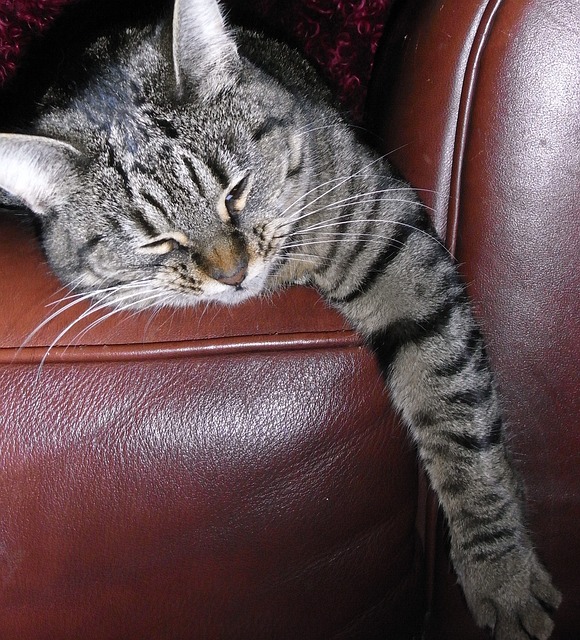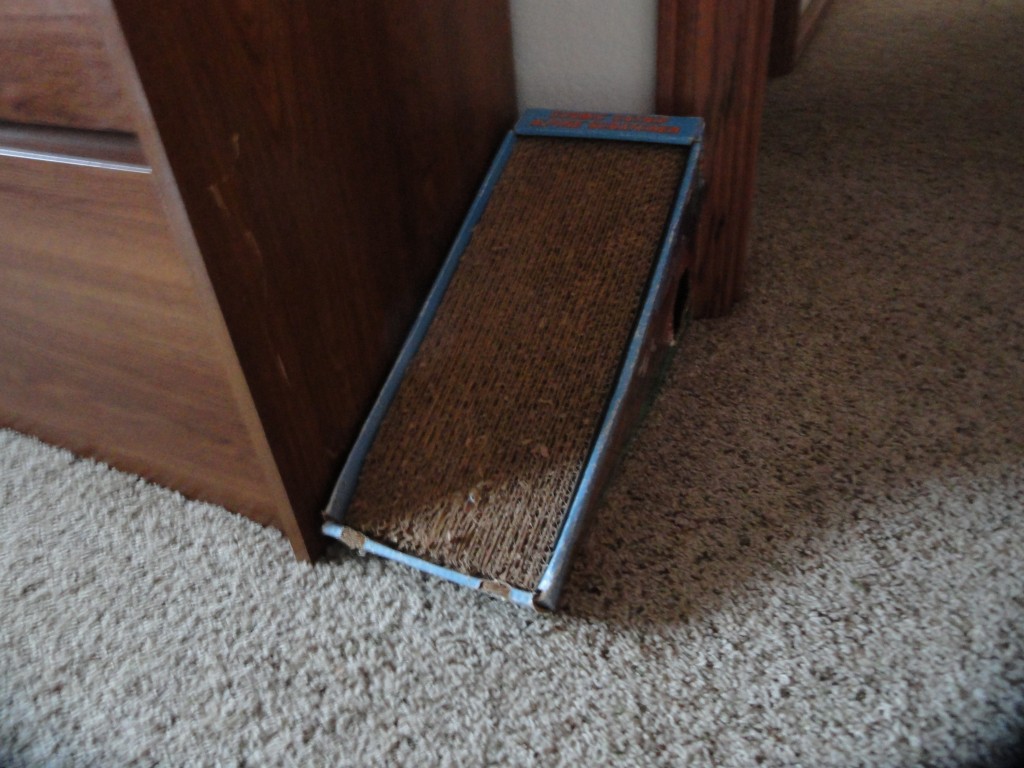
by Dr. Jess Franklin
Cats sharpen claws on many surfaces. This helps keep their nails from over-growing, and allows the cat to say, “I am here!!!” It is a common greeting behavior. If you don’t want cats scratching wherever they please, do not allow even mild attempts for scratching on furniture. Habits are hard to break. It is much easier to start correct behavior than stop established destructive problems.
A good product to help with scratching is Sticky Paws. Place different types of scratch pads in prominent important places in the home. For my house this is next to the bed, near the top of the stairs, and next to my recliner.
You can also use cardboard, sisal, or carpet with some pieces being flat, and some vertical or angled. Many cats that started life outdoors really would prefer a sturdy bark covered log. The scratch pad should be well anchored so it will not fall and scare the cat. Vertical posts should be tall enough for a cat to stretch fully. Cats are very flexible and a large cat can reach as high as a kitchen counter.
How can I stop the cats scratching the recliner?
- Cover the area that the cat has selected for scratching with something she does not want to scratch. Three options….a) a stretchy polar fleece or Knit afghan, b) a slippery clear guard to cover the corner, or c) a sticky cover (see Sticky Paws above).
- Move an inviting scratch post and cardboard scratcher as close to the problem area as possible. This makes scratching in the area ok, just not the recliner. Position the scratch post to block the cat from having access to the most desirable corner of the recliner.
- Play with the cat with a fishing pole or other flexible toy to get the cat to touch or grab at the surface of the desired scratch post.
- Make bad behavior seem risky. It is not a good idea to punish a cat, but it is great to make the cat think bad things happen when she scratches at the corner of the recliner. Do not hit your cat. Cats hate loud sudden noises, and they hate being surprised. Take advantage of this by throwing something hard…candy or walnut next to the cat to make a sharp sound while she is scratching the wrong object. Make it seem as if the noise came from the room, and not from you. Most scratching goes on when you are not there, and it is better for the room to make bad things happen than you.
- Start as soon as there is a problem. Do not tolerate just a little scratching.
- Trim scratch snags. The scratched, roughed up fabric is attractive to scratch on.
- Feliway diffuser or spray. The Feliway pheromone is a replica of face gland smell, and a room diffuser can be used in a outlet near the recliner. This may encourage face rubbing instead of scratching.
Leather furniture may need special protection. When a cat leaps, the rear nails push off. If a heavy cat jumps off the arm of the sofa, the nails can make holes. For leather, the best answer is to drape a fabric throw over the furniture so nails cannot damage the arms or back.
What about soft paws?
Soft paws are covers to glue over the nails to prevent damage to furniture from scratching. I do not like them for two reasons: 1. If not carefully monitored, the covered nail can grow too long and actually injure the toe pad. 2. Many cats hate to have paw covers applied, so it is a lot of work. They are a reasonable short term solution for special circumstances….the cat with the new puppy to prevent face injury from the cat, or the cat going home to visit mom’s house for the holidays or vacation.
What about declawing?
I have practiced veterinary medicine for over 30 years. I have known many well adjusted indoor cats that have been declawed and showed normal mobility and behavior after having this surgery. I have also treated some cats that had residual pain on jumping down on hard surfaces long after declaw surgery. I would rather the cat be trained to scratch in the correct place and keep her claws. Some cats that started life as indoor pets end up being outdoors and claws allow cat to climb outdoors better and have better protection.
If scratching behavior is uncontrollable, and the alternative is get rid of the cat, then I would prefer declawing.
The doctors and staff of the Ann Arbor Animal Hospital are available to answer any other questions you may have about scratching behavior in cats.
Recent Posts
About Us
Ann Arbor Animal Hospital is a locally-owned animal hospital operating for over 90 years in Ann Arbor, MI.

